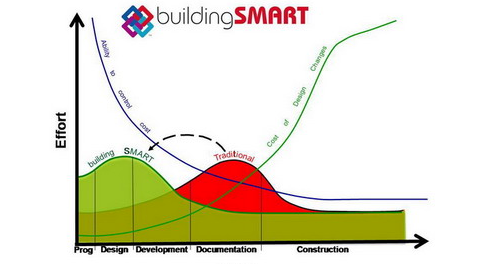Smart Construction is now needed to make tomorrow's Smart Buildings
Smart Construction is now needed to make tomorrow's Smart Buildings
It is time to invest in making the case for early modern construction procurement.
There is little doubt, that across today's worldwide construction industry the traditional way of specifying, designing, procuring, making, assembling, accepting and using buildings have passed their use-by date. There is still resistance from traditional public institutions and some influential stakeholders to hold on to old methods and their status. However, the tide is shifting fast. Whenever you hear what is now becoming an embarrassing narrative resisting change, being confronted by the modern construction reality you get a sense that it will soon be game over for the status quo.
This is no longer a debate where opinion alone can be relied upon to make the case. Everyday there are compelling and authoritative insights being shared amongst the global construction community. The line up of speakers at this year's PrefabAUS included Mark Farmer talking to his report to the UK's construction industry's clients, professions, industry associations, contractors, regulators and supply chains which pointed to the need to 'Modernise or Die: the construction industry's burning platform for change.'
There were others such as Robert Beson who spoke to new methods of 'Design Interpretation and detailing for Fabrication.' It soon became obvious new methods of measuring, procuring, making and assembling buildings was about to reshape the industry. Mikael Ludviggsson showed how a Smart Housing collaboration was unfolding in Sweden where regional innovation was being applied to world leading applications for wood and glass that is fostered by industry and local governments.
Meanwhile in the US, BuiltWorld's Buildings 2.0 got underway in Chicago a few days later. The themes: Smart vs. intelligent buildings.
The distinction between smart and intelligent buildings was a topic of discussion that tied many of the panels together. It gradually became clear that equipping buildings with sensors or using advanced design tools wasn’t enough — instead, we need to understand what the data from the sensors means and how to use this data to improve performance.
The speakers expanded on this general observation by pointing to a few key challenges using case studies and new technologies that are entering the market.
Some of these key challenges include:
- Continuing to drive innovation in design as it relates to specific parameters (such as environment, zoning, cost, urban form, etc.)
- Exploring new ways of certifying buildings
- Understanding how to use new products, materials, systems, and companies
- Advancing efficient building practices
- Integrating systems and technologies towards a building operating system
- Managing risk of new systems, technologies, and design methods
Building on Buildings 2.0: Our takeaways from the conference (opens in a new window).

This week Western Sydney University's Director of the Centre for Smart Modern Construction (c4SMC) Professor Srinath Perera and I visited Professor Paul Cooper, Director of the University of Wollongong's Sustainable Buildings Research Centre, and Timothy McCarthy Professor of Steel and Structures Design to see their work on Smart Buildings as part of their local collaborations with Bluescope Steel, Stockland and others. World class research and proof of concepts was on abundant display. They evidenced how smart design, smart build and smart use are the fundamentals that will underpin future asset values, resilience and sustainability. We are keen to collaborate with the University of Wollongong through our c4SMC initiative.
c4SMC is a Western Sydney construction industry capability building initiative. It will involve clients, advisors to the industry, the industry and government coming together to invest in research and apply the know how that will be required by modern constructors and the enterprises they will lead. c4SMC momentum is building with sufficient funds already committed to enable new scholarships and research to start in 2018. The point of difference being the creation by the industry's key stakeholders of a sustainable investment pipeline that is not dependent on the traditional sources for this work.
Organisations who see strategic opportunities arising from Western Sydney's emergence as Australia's third largest economic region are rationally committing to this industry engagement initiative. They reason the need to make an early investment to ensure the insights and capabilities that they will need will be there when they need them. Western Sydney's David Borger, Director - Western Sydney Business Chamber, NSW Business Chamber will launch c4SMC to the local industry on the 16th November.
c4SMC is already attracting international interest from potential collaborators and investors. This is a unique opportunity for universities, developers of modern construction technologies, manufacturers and organisations who want to be part of a Smart Modern Construction hub at the centre of Western Sydney, to get involved.
For details about c4SMC and how your organisation will benefit from investing in this collaborative initiative and being part of a strategic network of fellow travellers feel free to contact me at:
E: D.Chandler@westernsydney.edu.au
M: +61 418 676896
Written by:
David Chandler OAM
Adjunct Professor at Western Sydney University
27 September 2017
RHC Buttons
Mobile options:

